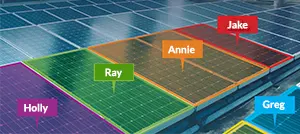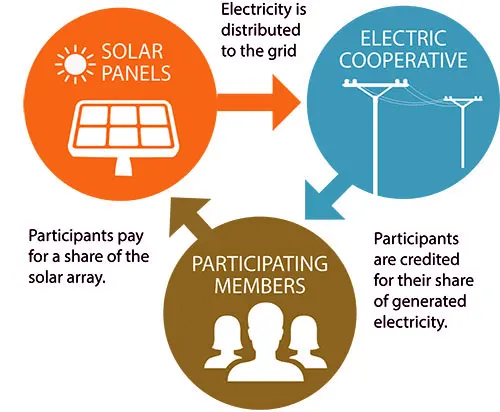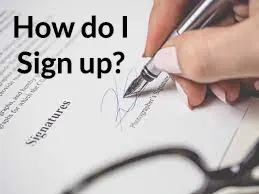Solar energy is well on its way to becoming the biggest renewable energy source in the United States. According to multiple surveys, a growing proportion of American citizens are interested in going solar. Experts also estimate that by 2024, there will be an average of one installation per minute in the country.
How do you imagine this trend? You probably see thousands of solar installers moving across rooftops until every roof in America is shining with panels, right? While that’s mostly true, it’s not exactly accurate; installing solar panels isn’t an option for everyone.
For one reason or another, some people can’t or won’t own a private solar panel system. But that doesn’t necessarily mean that they will be excluded from our renewable future.
Enter community solar; installations that allow you to enjoy the benefits of solar energy without necessarily installing solar panels on your home.
What is community solar?
The SEIA defines community solar as “ local solar facilities shared by multiple community subscribers who receive credit on their electric bills for their share of the power produced.” On the other hand, the US. Department of Energy defines it as “ any solar project or purchasing program, within a geographic area, in which the benefits of a solar project flow to multiple customers.”

Simply put, a community solar program is a solar project that any homeowner or business owner within a particular area can access. There’s a solar farm involved, and participants usually own shares in the project. This principle pretty much shatters the way people think about accessing the sun’s renewable energy.
According to the SEIA, there are 40 states with at least one working community solar project. Among these, 22 states actively try to encourage the growth of shared renewables by implementing favorable policies and programs.
Why is community solar necessary?
As stated earlier, not everybody can install solar panels in their home. For some, it’s a choice, but for the majority, it’s a circumstance. This majority represents millions of people facing any one of the following obstacles;
They don’t own their homes
Renting statistics estimate that 44.1 million (35.9% of American households) rent their homes. And if you’ve ever rented space, you probably understand how easy it isn’t to add a fixture to the home. Unfortunately, that is exactly what has prevented most American renters from enjoying the benefits of solar energy.
They have unsuitable roofs

Some people own their homes, but they don’t exactly have a suitable rooftop for solar installation. The National Renewable Energy Laboratory Statistics show that 50% of all American rooftops are shaded, don’t orient toward the south, or lack the minimum required roof space for solar installation.
Another similar situation faces people living in a condominium. You own the house, but you can’t exactly claim the roof space. Therefore, installing solar panels is practically impossible unless everyone decides that they want the same thing.
Financial reasons
Solar is usually advertised as the cost-efficient energy alternative, but installing a home solar system isn’t exactly the cheapest of projects. Good solar systems cost an average of $12,000 to $15,000 in up-front installation costs, an amount not everybody can afford.
Realizing that a viable energy solution does not exclude proponents of solar as renewable proposed community solar as a way around these challenges.
How does community solar work?
Solar farms sit at the core of community solar projects. These farms are responsible for generating electricity, which is then distributed to the local community. To make such projects viable, these farms are developed and built in areas with enough sunlight to produce at least 1200kWh.
The solar power produced is usually aggregated on a host meter to track the farm’s production.

The size of community solar farms across the United States ranges from as small as 350kW to as large as 150 MW. One megawatt of solar energy could theoretically service around 160 homes, meaning the typical 2,000kW community farm can support up to 360 homes and businesses.
Electricity produced by community solar programs is then sent to your local power grid, allowing you to receive credits on your monthly utility bills. The key thing to note is that you’re not exactly getting the power your panels produce on the farm. So, how does this work? Enter remote net metering.
What is remote net metering?
Remote net metering (RNM) or virtual net metering (VNM) is an arrangement that allows customers of community solar and wind energy farms to transfer the generated power to the grid in exchange for credits on their monthly utility bills.
Many people believe that savings from solar power involve substituting some of their grid electricity with solar energy. However, it’s physically impossible for community solar companies to send you electricity from your solar farm, which means you’re still using grid electricity to meet all your energy needs.
RNM means you don’t have to worry about where your power is coming from. The solar farm’s output is directed to the grid, then the relevant amount of credits generated is calculated depending on your share of total power production. Since solar energy is cheaper, you still get to enjoy its cost-saving benefits.
How do I Sign Up for Community Solar?
If there is an active community solar program where you live, joining it should be quite easy. Some states allow you to sign up through your utility, while others support online signing up.

Community solar providers may also require a credit score to determine a subscriber’s likelihood to pay for their bill. However, this practice is becoming less common as providers look to open the doors of community solar to more customers.
Many community solar programs also have an upper limit on how much electricity a single customer can receive from their project. This is usually no more than 120% of a customer’s monthly usage.
Your local provider will provide you with any other relevant information regarding their program.
Community solar participation models
Community solar projects allow participation in either one of the following ways;
Ownership
Participants purchase a share of the solar project, which is usually as a select number of panels. It is similar to buying a rooftop solar system, only in this case, there will be no panels installed in your home. At the end of the month, you’ll get electric bill credits proportional to the power produced by the solar panels you own.
Some community solar providers also allow their customers to purchase a certain number of kilowatts of the solar farm’s total capacity.
Subscription
In the subscription model, you don’t own a share of anything. Rather, you pay a monthly subscription fee to the community solar provider. Think of it as the Netflix of solar energy. It may sound expensive at first glance, but you’re actually only buying electricity at a lower price than you usually do from your utility.
Due to its convenience and virtually no upfront costs involved, the subscription-based model is the most popular approach to community solar.
Benefits of community solar
Community solar comes with many benefits, the biggest being that it eliminates the need for bothersome installations. Therefore, you don’t have to own a home to reap some solar energy. Renters make up a huge proportion of American homes, and community solar looks provide each one with the opportunity to use solar energy. The same benefit extends to people with unsuitable roofs for installations and those living in condominiums.

Subscribing to community solar also carries no upfront costs. A good number of the American population can’t afford to spare $12,000 to purchase a decent rooftop system. But with an active project in their area, they don’t have to. A monthly subscription should provide them with all the solar power they need.
Affordable community solar also allows American communities to enjoy some sort of energy independence. On top of that, it supports the local economy as the solar industry employs hundreds of thousands of people in the United States.
According to the SEIA, there were around 231,474 solar workers in the country in 2020, although this represented a 6.7% drop from 2019. As the industry recovers from the pandemic and the community solar market grows, this demographic is expected to rise. By 2030, the solar industry will have created 400,000 solar jobs and over 900,000 just five years later.
Participants also reap the typical solar energy benefits, like paying cheaper utility bills to save money. For example, if they own a panel, their share in the project is deducted from their total monthly electricity bill. On the other hand, subscribers pay a cheaper price for electricity than if they bought it from their utility provider.
There is also the fact that solar energy is our best bet to stopping climate change. Community solar plays an undeniably crucial role in providing solar energy to people who would otherwise have never had access to solar energy. As more people realize that they can access solar power at a relatively cheaper price, the demand for solar energy rises, and our reliance on fossil-fueled sources drops.
